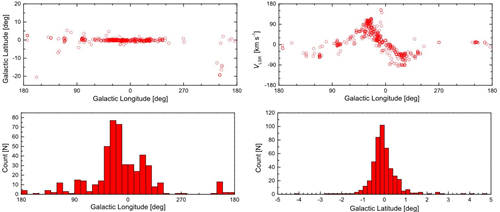搜索结果: 1-14 共查到“天文学 A 1.4 GHZ”相关记录14条 . 查询时间(0.051 秒)

95 GHz I型甲醇脉泽搜寻获进展(图)
95 GHz I型 甲醇 脉泽 搜寻
2017/6/5
脉泽(Microwave Amplification by Stimulated Emission of Radiation) ,即微波受激发射放大,可简单理解为微波波段的激光。甲醇脉泽广泛地分布于恒星形成区,是研究演化早期阶段的大质量年轻恒星的有力工具。根据它们所在的区域,甲醇脉泽可分为I型与II型甲醇脉泽。II型甲醇脉泽通常与UC HII区、红外源、OH脉泽等成协,而I型甲醇脉泽通常偏离这些区...

脉泽(Microwave Amplification by Stimulated Emission of Radiation) ,即微波受激发射放大,可简单理解为微波波段的激光。甲醇脉泽广泛地分布于恒星形成区,是研究演化早期阶段的大质量年轻恒星的有力工具。根据它们所在的区域,甲醇脉泽可分为I型与II型甲醇脉泽。II型甲醇脉泽通常与UC HII区、红外源、OH脉泽等成协,而I型甲醇脉泽通常偏离这些区...

2015年12月7日09:05(BJT)起,中国科学院上海天文台65米口径天马望远镜与由韩国3台站VLBI网(KVN)和日本4台站VERA组成的KaVA联合开展的43 GHz VLBI观测(代码k15tj02d)获得成功。天马望远镜使用常温Q波段接收机(图1),数据采集终端为DBBC2,数据记录速率为1 Gbps(16ch,16MHz,2bit)。中国科学院上海天文台DiFX处理机和韩日硬件相关处...
A survey of 557 GHz water vapor emission in the NGC 1333 molecular cloud
NGC 1333 jets and outfl ows
2014/12/24
Using NASA's Submillimeter Wave Astronomy Satellite (SWAS), we have examined the production of water in quiescent and shocked molecular gas through a survey of the 556.936 GHz 110-101 transition of or...
Optical Identification of Infrared Space Observatory Far-Infrared Sources in the Lockman Hole Using a Deep Very Large Array 1.4 GHz Continuum Survey
evolution starburst
2014/12/24
By exploiting the far-infrared (FIR) and radio correlation, we have performed a likelihood-ratio analysis to identify optical counterparts to the FIR sources that have been found in an area of ~0.9 de...
Diffractive and refractive timescales at 4.8 GHz in PSR B0329+54
stars: pulsars: individual: PSR B0329+54 - ISM: structure - plasma - turbulence
2011/10/9
We present the results of flux density monitoring of PSR B0329+54 at the frequency of 4.8 GHz using the 32-meter TCfA radiotelescope. The observations were conducted between 2002 and 2005. The main go...
A 95 GHz Class I Methanol Maser Survey Toward GLIMPSE Extended Green Objects (EGOs)
Maser Survey GLIMPSE Extended Green Objects
2011/10/9
We report the results of a systematic survey for 95 GHz class I methanol masers towards a new sample of 192 massive young stellar object (MYSO) candidates associated with ongoing outflows (known as ex...
We observed at 22 GHz with the VLBI array VERA a sample of 1536 sources with correlated flux densities brighter than 200 mJy at 8 GHz. One half of target sources has been detected. The detection limit...
Optical Properties of High-Frequency Radio Sources from the Australia Telescope 20 GHz (AT20G) Survey
catalogues – radio continuum:galaxies – galaxies:active – galax-ies:evolution
2011/10/8
Our current understanding of radio-loud AGN comes predominantly from studies at frequencies of 5 GHz and below. With the recent completion of the Australia Telescope 20 GHz (AT20G) survey, we can now ...
The Allen Telescope Array Pi GHz Sky Survey II. Daily and Monthly Monitoring for Transients and Variability in the Bootes Field
Monthly Monitoring Transients Variability Bootes Field
2011/9/29
We present results from daily radio continuum observations of the Bootes field as part of the Pi GHz Sky Survey (PiGSS). These results are part of a systematic and unbiased campaign to characterize va...
The Atacama Cosmology Telescope: Sunyaev Zel'dovich Selected Galaxy Clusters at 148 GHz in the 2008 Survey
Cosmology and Extragalactic Astrophysics (astro-ph.CO)
2010/12/24
We report on twenty-three clusters detected blindly as Sunyaev-Zel'dovich (SZ) decrements in a 148 GHz, 455 square-degree map of the southern sky made with data from the Atacama Cosmology Telescope 20...
Discrete Source Survey of 6 GHz OH emission from PNe & pPNe and first 6 GHz images of K 3-35
Solar and Stellar Astrophysics (astro-ph.SR)
2010/12/23
The aim of this study is to investigate the physical properties of molecular envelopes of planetary nebulae in their earliest stages of evolution. Using the 100m telescope at Effelsberg, we have under...
A 1.4 GHZ and 14.7 GHZ analysis of density gradients in galactic planetary nebulae
A 1.4 GHZ 14.7 GHZ density gradients galactic planetary nebulae
2009/7/9
A 1.4 GHZ and 14.7 GHZ analysis of density gradients in galactic planetary nebulae。
THE STRONGEST 100 RADIO POINT SOURCES IN THE FIELD OF THE LARGE MAGELLANIC CLOUD AT 1.4 GHz
Radio Continuum: galaxies Magellanic Clouds Catalogs
2010/10/29
We present the 100 strongest 1.4 GHz point sources from a new mosaic image in the direction of the Large Magellanic Cloud (LMC). The observations making up the mosaic were made using Australia Telesco...

